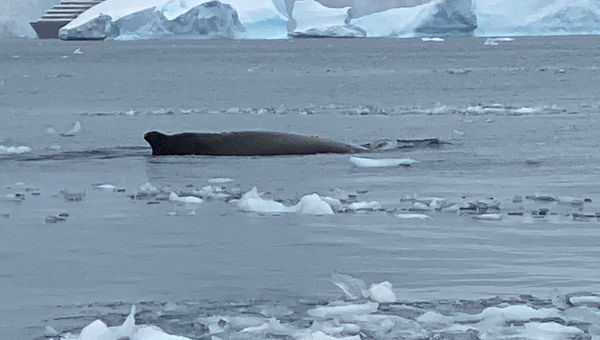CIERVA COVE, Antarctic Peninsula -- Humpback whales all around.
That's the easiest way to describe my final excursion in Antarctica.
Over the course of six days cruising this glorious region of mountains, sea, glaciers and icebergs aboard the Scenic Eclipse, I had witnessed everything from penguins feeding their chicks to fur seals resting on tiny islands of sea ice. Skua birds had landed practically at my feet. One day I even brought out my trusty Helinox camping chair and, in the mode of my desert sitting experience, sat quietly for hours, taking in a scene of rocks, ice, penguins and sea from a couple hundred feet above the water level as a cold wind grew steadily stronger.
But despite 11 different trips off the Eclipse for excursions on land and sea, and by Zodiac, helicopter, submarine, kayak and paddle board, I'd had nothing more than distant whale sightings.
On this twelfth excursion, however, amid light snow, my guide Angel Grimaldi hit pay dirt. As the Zodiac ferried eight other passengers and me slowly through the water, dodging floating chunks of sea ice, it seemed like humpbacks were everywhere. Two, sometimes three of the sleek, black whales surfaced at a time. And just as we'd frantically align our cameras in search of that perfect tail shot, another humpback would surface in another direction.
Unconcerned about potential whiplash, we'd jerk our heads, repoint our cameras and try again.
Eventually, after enough sightings, we started to gather a modicum of familiarity with the patterns of the whales. They'd emerge head-first, sometimes with their mouth open from feeding. After that, they'd swim close to the surface for a minute or two, re-emerging at times, hump first. As they swam just below view, we could follow their progress by what are known colloquially as whale footprints: marks on the surface that the whales create as they displace water.
Eventually the whales would arch their back and dive. If a whale showed its tail, we'd know the dive was likely to be deep one. No tail meant a shallower dive, and therefore a quicker re-emergence.
Grimaldi drove us patiently around the bay, extending the Zodiac cruise beyond its scheduled ending time. On one occasion, two whales emerged from a dive not more than ten yards from our small craft. Humpbacks are often close to 50 feet in length. The Zodiac measured just 19 feet. Still, it wasn't scary. Humpbacks dine mostly on krill. We were of no interest.

A surfacing humpback whale is framed by ice; the Scenic Eclipse is in the background. Photo Credit: Robert Silk
Eventually, we reluctantly headed back toward the Eclipse. After a detour to see an Argentine research station called Primavera, and another to view a colony of chinstrap penguins, we made haste for the ship.
Just before we reached the Eclipse we encountered one last whale. The snow had stopped by then. I put my camera away and simply watched, absorbing an extraordinary scene that I wished would last much, much longer.